Physical Address
304 North Cardinal St.
Dorchester Center, MA 02124
Localized arthritis can be caused by metastatic disease, cartilaginous tumors, foreign body synovitis, synovial osteochondromatosis, pigmented villonodular synovitis, and palindromic rheumatism.
Polyarthritis can be caused by carcinomatous polyarthritis, bypass arthritis, hypertrophic osteoarthropathy, intermittent hydrarthrosis, multicentric reticulohistiocytosis, SAPHO syndrome (synovitis, acne, pustulosis, hyperostosis, and osteitis), and Whipple disease.
Systemic syndromes can be associated with angioimmunoblastic T-cell lymphoma, Castleman disease, and leukemia.
Musculoskeletal complications of chronic kidney disease are frequently faced by clinicians caring for these patients; apatite (basic calcium phosphate) disease is the most common.
Gadolinium-induced fibrosis (nephrogenic systemic fibrosis) is a debilitating fibrosing condition affecting patients with chronic kidney disease after exposure to gadolinium-containing contrast agents during imaging studies.
Medications used to manage musculoskeletal conditions, such as colchicine and allopurinol, require careful assessment and dose adjustment in the context of dialysis and renal transplantation.
When considering the relationship between cancer and musculoskeletal disease ( Box 215.1 ), it is helpful to consider four major aspects: (1) the association of several rheumatologic disorders with an increased risk of malignancy; (2) musculoskeletal manifestations of cancer, including metastatic disease and paraneoplastic syndromes; (3) malignancies that may present with clinical features mimicking those of a rheumatologic disease; and (4) musculoskeletal adverse effects of drugs used in cancer management.
Synovial sarcoma
Cartilaginous tumors
Metastatic disease
Paraneoplastic syndromes
Raynaud syndrome
Erythema nodosum
Lupus-like syndrome
Eaton-Lambert syndrome
Myositis associated with malignancy
Vasculitis associated with malignancy
Carcinomatous polyarthritis
Hypertrophic osteoarthropathy
Palmar fasciitis and polyarthritis syndrome
Oncogenic osteomalacia
Musculoskeletal side effects of anti-cancer drugs
An association between malignancy and autoimmune disease has been demonstrated for several rheumatologic disorders and has been hypothesized for others. The strongest association is that between adult-onset polymyositis or adult-onset dermatomyositis and malignancy. A full description of the details of this association is beyond the scope of this chapter; however, the incidence of malignancy is increased among patients with either polymyositis or dermatomyositis, particularly that of solid tumors. Polymyositis and dermatomyositis are associated with a significantly increased risk of developing lung cancer among men; dermatomyositis is associated with a significantly increased risk of developing pancreatic carcinoma among men and an associated risk for colon, breast, and ovarian carcinomas among women. In addition, cases have been reported in which the inflammatory myopathy can be considered as paraneoplastic disease because it resolved after curative resection of the malignancy. Thus adults with polymyositis or dermatomyositis should be evaluated for evidence of an underlying malignancy; however, beyond age-appropriate screening tests, the extent of such an evaluation has not been clarified.
Another definite association is between rheumatoid arthritis (RA) or Sjögren syndrome (primary and secondary) and non-Hodgkin lymphoma. Among patients with RA, the incidence of non-Hodgkin lymphoma (primarily B-cell lymphomas) is two- to threefold that in the general population. In patients with Sjögren syndrome, lymphocyte proliferation becomes more oligoclonal over time, and the incidence of non-Hodgkin lymphoma is four- to sixfold that of the general population. These associations are confounded by the possible increased risk of lymphoma conferred by some of the drugs used to treat patients with these diseases, such as methotrexate, azathioprine, cyclosporine, and cyclophosphamide, However, insufficient data exist to establish a causal relationship between treatments for RA and the development of lymphoma.
Small observational studies suggest an association between systemic lupus erythematosus (SLE) and malignancy, with an increased risk of developing breast, lung, and cervical carcinomas and lymphoid malignancies such as non-Hodgkin lymphoma that is unrelated to the use of cytotoxic agents. Although a retrospective study suggested an increased risk of lung carcinoma among patients with scleroderma and interstitial pulmonary fibrosis, this observation was not confirmed in a population-based cohort study.
Vasculitides, especially those associated with antineutrophil cytoplasmic antibodies (ANCAs), may develop in association with myelodysplasia, hematologic and lymphoid malignancies, and solid tumors. Cutaneous leukocytoclastic vasculitis is associated more with the presence of hematologic malignancies than with solid tumors. Some patients with hairy cell leukemia develop a cutaneous small-vessel vasculitis. Antiphospholipid antibodies, with or without vasculitis, may be present in patients with malignancy.
Other conditions seen by rheumatologists may also be associated with malignancy. Patients with multicentric reticulohistiocytosis may develop solid tumors. Patients with Paget disease of bone have an increased risk of developing osteogenic sarcomas, primarily in involved bones. Additionally, gouty arthritis can complicate chronic myeloproliferative disorders, and the aggressive treatment of leukemia and other malignancies can cause tumor lysis syndrome.
Synovial sarcoma is an uncommon soft tissue malignant tumor that is misnamed because it arises from tissue adjacent to the joint and rarely, if ever, from the synovium. Oncogenesis is driven by the chromosomal translocation t(X;18)(p11;q11). It develops most commonly between the third and fifth decades of life, but it may also occur in children and adolescents. It generally presents as a mildly to moderately painful mass on a limb, more often on the leg, but it can be painless. These tumors adhere to adjacent structures, and symptoms are a consequence of local invasion. A soft tissue tumor is a strong indication for magnetic resonance imaging (MRI), which may prompt histologic examination, even if it appears as clinically benign. The average time from onset to diagnosis of synovial sarcoma ranges from months to years, and these lesions are often misdiagnosed as benign growths before histologic analysis demonstrates them to be synovial sarcomas.
Radiographs may reveal a well-circumscribed soft tissue mass that frequently contains calcifications ( Fig. 215.1 ); however, in about half of synovial sarcomas, plain radiographs yield normal findings. Occasionally, periosteal reaction and even bone invasion are evident. Bone scans and computed tomography (CT) ( Fig. 215.2 ) demonstrate the extent of the lesion and associated bony reaction. Angiograms reveal typical neovascularization and tumor blush. However, MRI with gadolinium-based contrast enhancement is the imaging procedure of choice because it suggests the malignant nature of the lesion and the degree to which adjacent soft tissue structures, such as vessels and nerves, are involved ( Fig. 215.3 ). Additionally, MRI can help to localize the optimal site for percutaneous biopsy to make a histologic diagnosis. Surgical excision should include the tumor and its margin, if possible, as well as the biopsy route, which therefore should be decided after consultation of the surgeon.
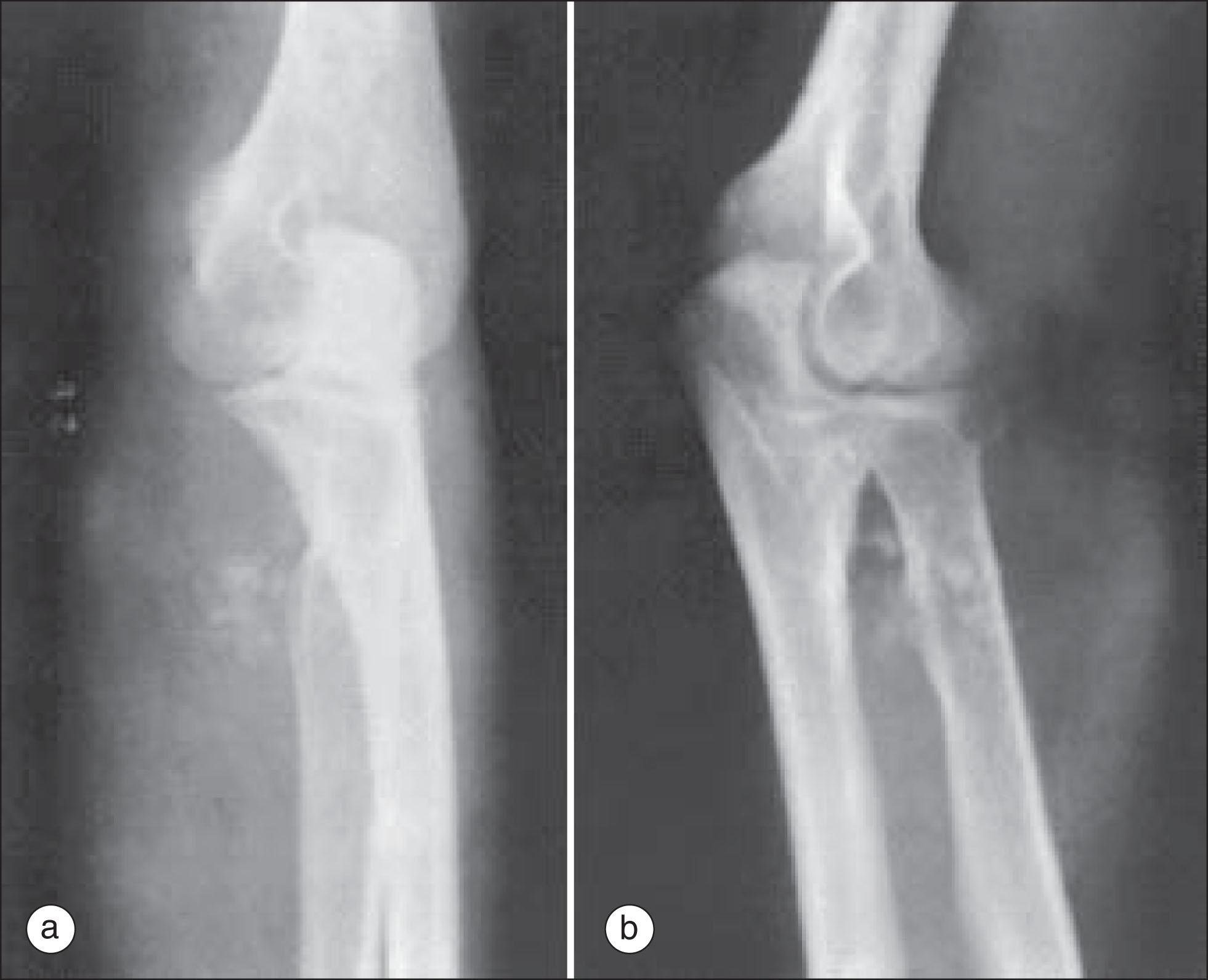
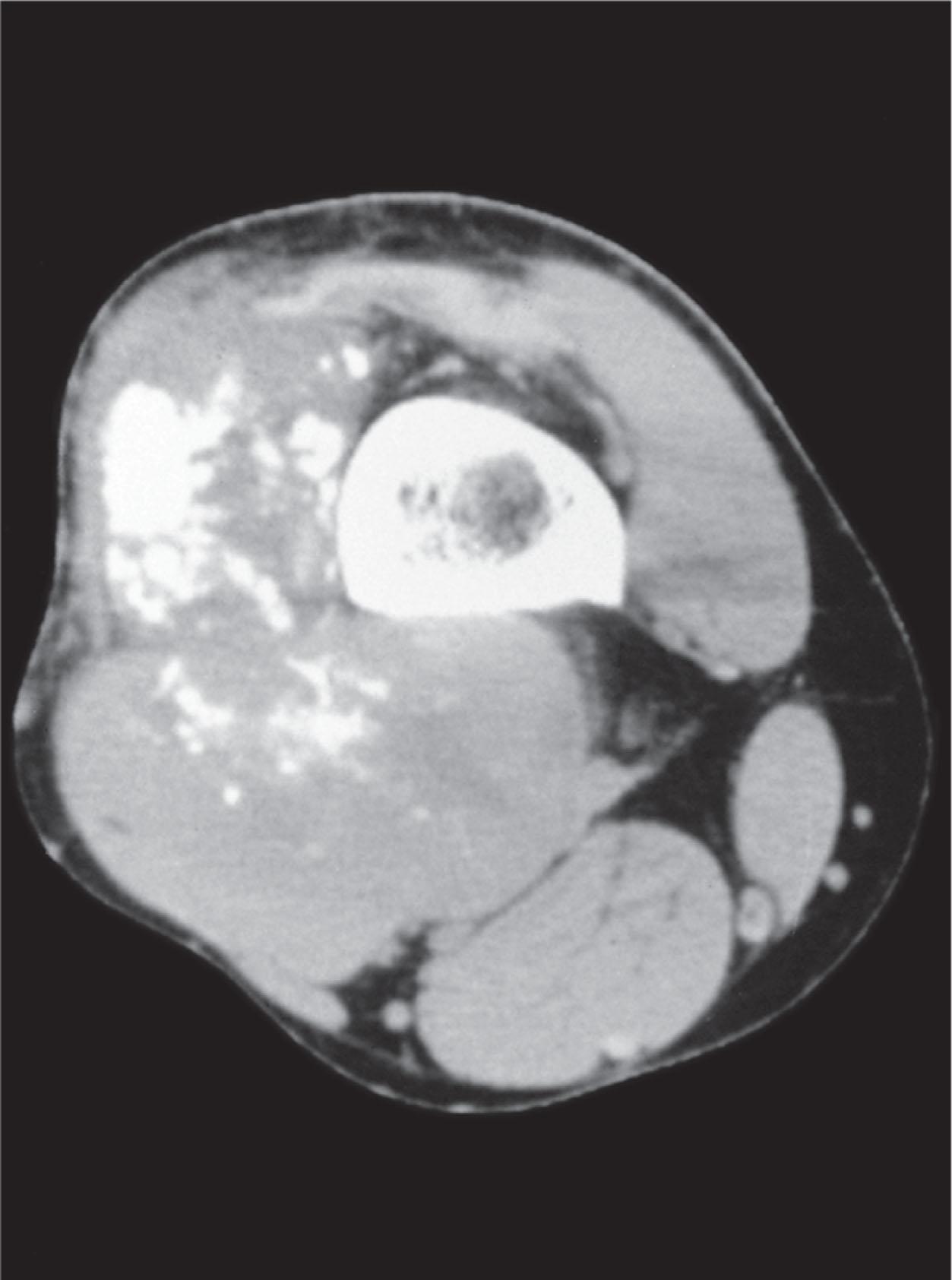
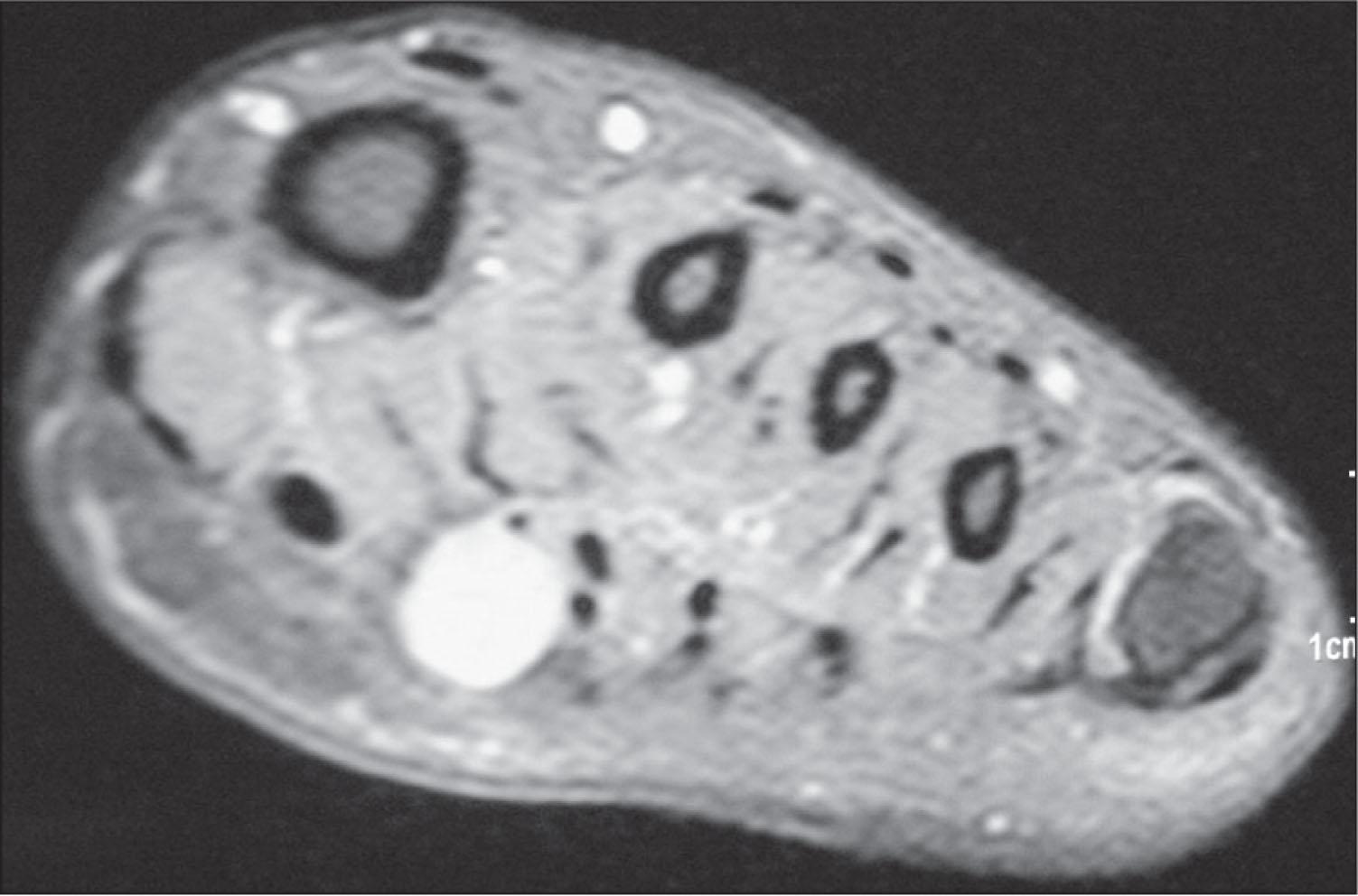
Grossly, the tumor is a circumscribed mass that adheres to the underlying tissue and to adjacent tissue structures. It is usually solid, but occasionally cystic changes may be noted. Because histologic evaluation of synovial sarcomas is difficult, expertise should be sought, and diagnoses are frequently changed on re-review of the tissue. Other tumors that may be confused with synovial sarcoma include epithelioid sarcomas, clear cell sarcomas, and fibrosarcoma.
The typical histologic pattern of synovial sarcomas is biphasic with two distinct cell types: fibrosarcoma-like spindle-shaped cells and epithelial cells ( Fig. 215.4 ). Spindle cells usually are the predominant cell type and have a characteristic swirling appearance with large nuclei and scant cytoplasm. These swirls appear to make clefts, at the border of which epithelial cells are often arranged. The more frequently mitotic figures are seen, the more dedifferentiated the tumor, with a greater likelihood of vascular invasion and poorer prognosis. The epithelial cell component is occasionally sparse but can be visualized by silver stains that identify reticulin within the cytoplasm. The spindle cells have keratin, which can be identified by immunohistochemical analysis. Occasionally, only a single cell type (most often spindle cells) is seen, which may cause difficulty in making the diagnosis.
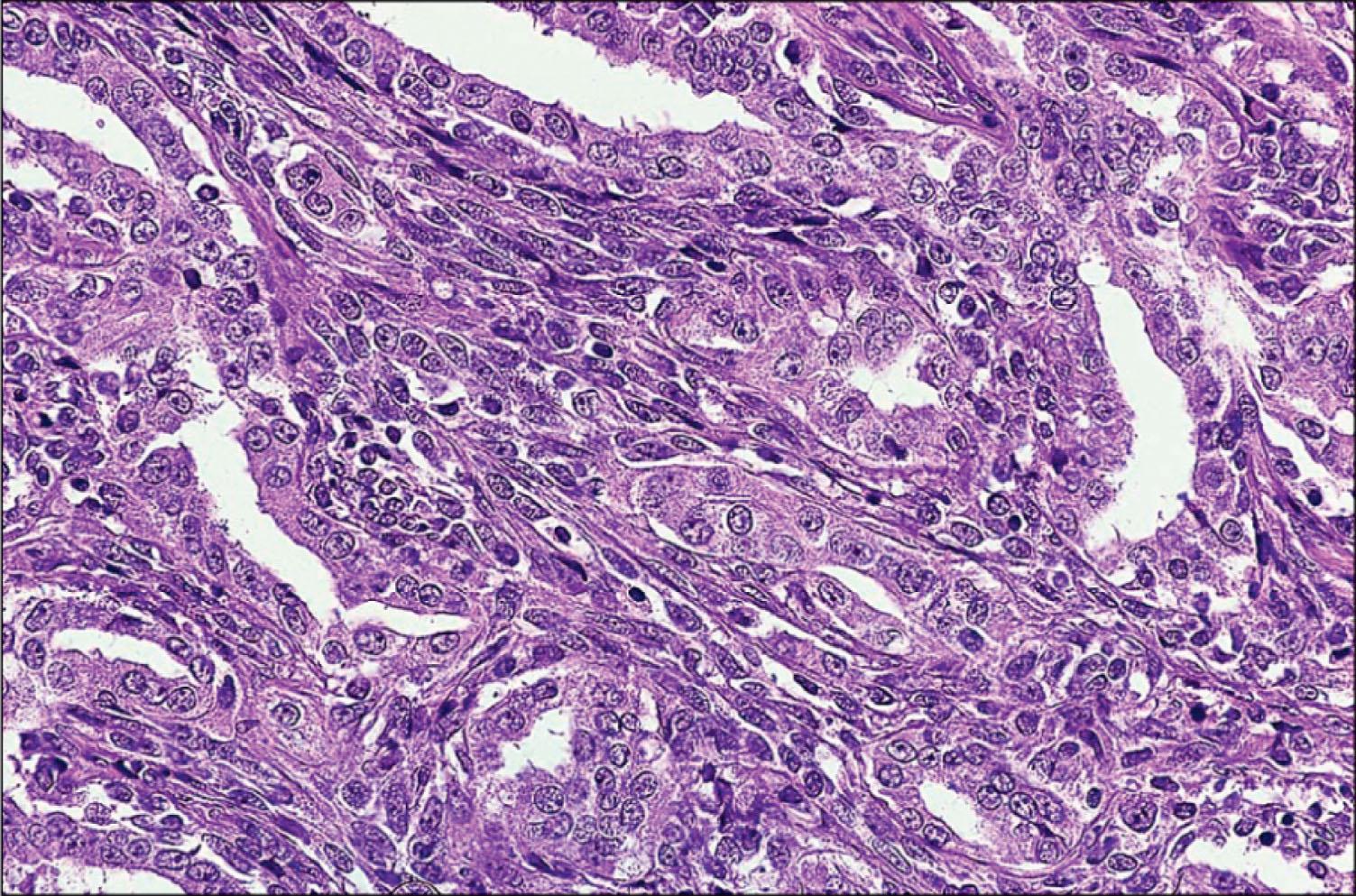
Treatment consists primarily of surgical resection, which usually achieves good results for small, localized tumors with favorable histologic features. Radical resection, with or without amputation, is performed for larger, less well-differentiated tumors. Unfortunately, distant metastases are often discovered subsequently. Radiation therapy (40–75 Gy) is often administered after surgical resection, resulting in fewer relapses and better survival than among those treated with surgery alone. Combination chemotherapy with ifosfamide and doxorubicin (with or without vincristine) may be given before surgery and irradiation to improve survival and lengthen the disease-free interval. The 5-year overall survival rate is about 75%, with the prognosis being better for younger patients and for those with localized disease and tumors smaller than 5 cm in diameter.
Cartilaginous tumors are discussed in Chapter 218 .
Metastasis of lung or breast carcinoma and, infrequently, of kidney or prostate cancer to the proximal or distal end of long bones can present as joint or periarticular swelling ( Fig. 215.5 ). This typically occurs around the knee but may occur elsewhere, even in the small joints of the hands. Very infrequently, multiple metastatic lesions result from disseminated carcinoma. Cancer metastatic to the synovium has been reported infrequently.
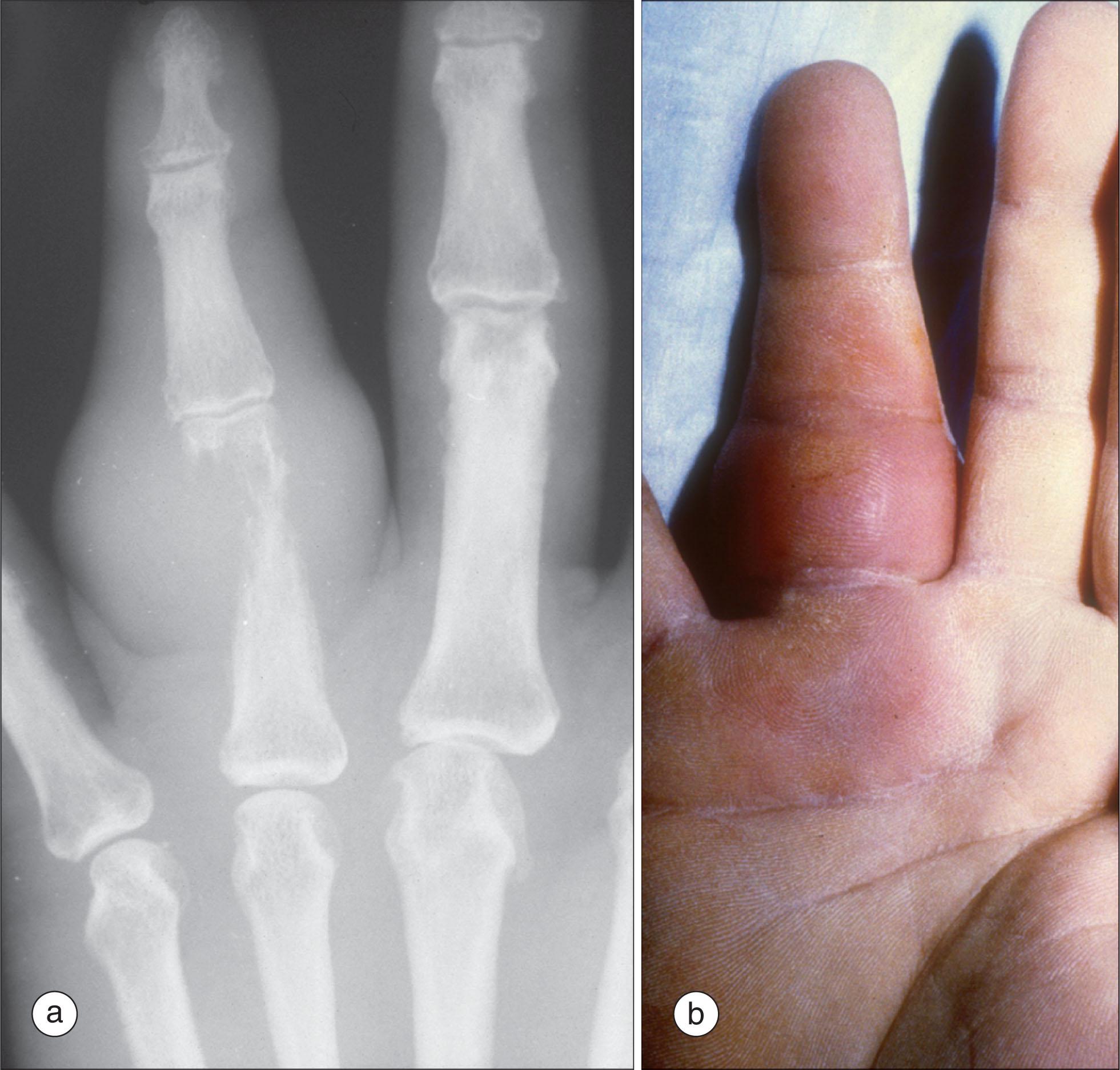
Paraneoplastic rheumatic syndromes are rare. They occur in a variety of cancers but are not caused by the local presence of cancer cells and seem to be mediated by humoral factors excreted by tumor cells or by an immune response against the tumor. Sometimes the symptoms of paraneoplastic syndromes show even before the diagnosis of a malignancy. Raynaud syndrome, erythema nodosum, lupus-like syndrome, and Eaton-Lambert syndrome can be rheumatologic paraneoplastic syndromes. Myositis and vasculitis associated with malignancy (see earlier) could also be classified as paraneoplastic.
Up to 20% of patients affected by myelodysplastic syndromes have associated autoimmune diseases or inflammatory arthritis, which include relapsing polychondritis, systemic vasculitis (most frequently polyarteritis nodosa and giant cell arteritis), Sweet syndrome, SLE, polymyalgia rheumatica, RA, RS3PE (remitting seronegative symmetric synovitis with pitting edema) syndrome, and undifferentiated arthritis. Patients respond to steroids but have a high rate of steroid dependence. Drugs aimed at the myelodysplastic syndrome, particularly azacytidine, may improve articular and systemic symptoms.
Solid tumors, particularly of the breast and lung, are occasionally accompanied by an asymmetric inflammatory polyarthritis involving large and small joints. This nonerosive, usually seronegative arthritis, which can present as RS3PE syndrome, may remit upon treatment of the underlying malignancy; otherwise, it can be treated with nonsteroidal antiinflammatory drugs (NSAIDs) or glucocorticoids, but these are not usually effective. Very infrequently, it can be an early clue to the presence of an occult malignancy; however, with the frequency of cancer and arthritis being high in the general population, their coexistence does not necessarily imply causation.
Patients with pancreatitis, and occasionally those with pancreatic carcinoma, may develop a large joint arthritis, often involving the ankles, accompanied by intensely inflamed subcutaneous nodules that resemble erythema nodosum. These nodules, which often are several centimeters in diameter, may ulcerate and drain. Unlike with true erythema nodosum, recovery results in local cutaneous depression caused by adipocyte necrosis. Biopsy of the nodule reveals septal panniculitis like that seen in erythema nodosum but accompanied by fat necrosis presumably caused by release of pancreatic lipase, increased levels of which can be found in the blood. Synovial or bursal fluid obtained from these patients can appear milky because of the large numbers of fat droplets that result from necrosis of the fatty synovium.
Hypertrophic osteoarthropathy is discussed in Chapter 214 .
Two publications in 1982 reported the novel association of palmar fasciitis ( Fig. 215.6 ), polyarthritis, and ovarian carcinoma. Previously these symptoms had probably been reported as paraneoplastic complex regional pain syndrome. The palmar fasciitis and polyarthritis syndrome is rare. It occurs in patients with a variety of neoplastic diseases: primarily ovarian most frequently but also breast, lung, pancreatic, and gastric carcinomas; Hodgkin disease; and chronic myelogenous leukemia. The hallmark of the syndrome is inflammation of the palmar fascia, which results in flexion contractures with nodular thickening and marked induration of subcutaneous tissues that has prompted use of the descriptive term “woody hands” ( Fig. 215.7 ). Biopsy of the palmar fascia reveals nodules or whorls of fibroblasts surrounded by dense connective tissue with fibrous septa. The polyarthritis involves predominantly the metacarpophalangeal and proximal interphalangeal joints and the wrists, with carpal tunnel syndrome. Other joints usually are less severely affected. The mechanism by which this syndrome develops remains unknown. Some have suggested an autoimmune etiology, based on the presence of immunoglobulin deposits in biopsy specimens. Palmar fasciitis may improve with chemotherapy or surgery to treat the underlying malignancy, but many patients have widespread metastatic disease at the time of initial presentation.
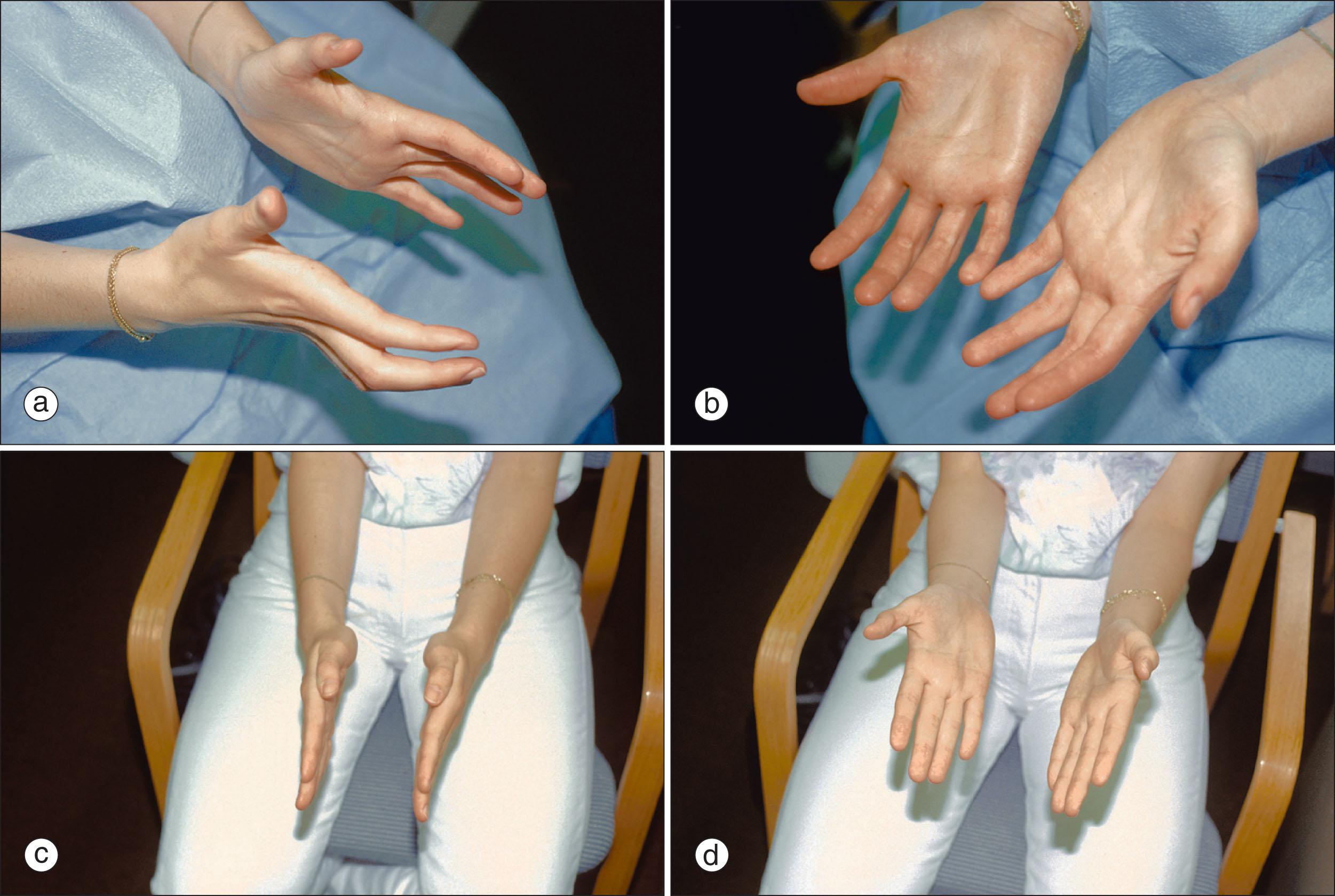
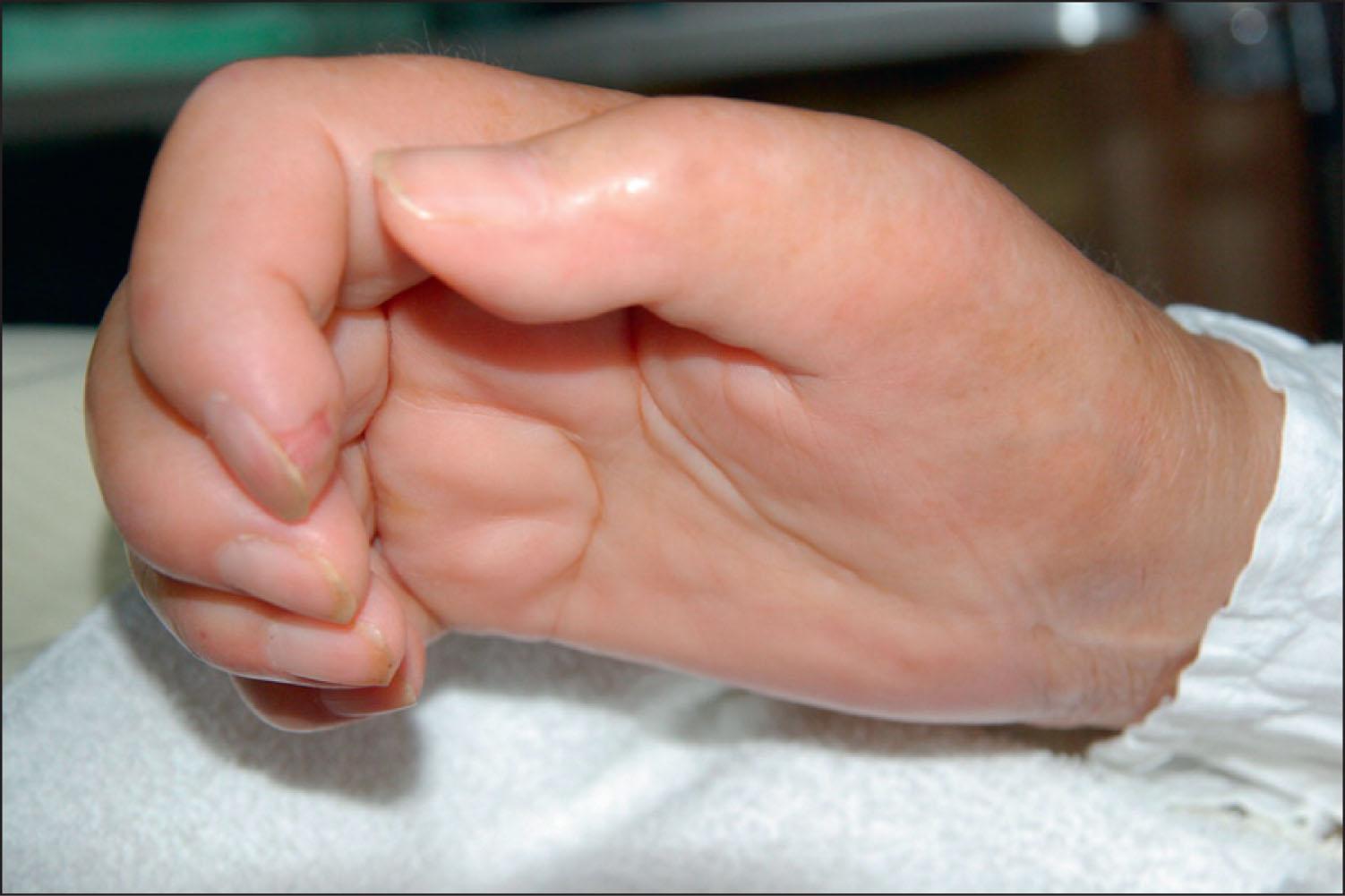
Oncogenic osteomalacia is one of the best understood paraneoplastic disorders. It is caused by the secretion of fibroblast growth factor (FGF) 23 by osteocytes in phosphaturic mesenchymal tumors (PMTs). PMTs are usually benign and small, making them difficult to diagnose. They are composed of spindle-shaped or stellate cells embedded in a mesenchymal myxoid or myxochondroid matrix, which partly calcifies. They have a rich microvascular supply that can mimic hemangiopericytomas. FGF23 inhibits phosphate reabsorption in the proximal tubular cells of the kidney, resulting in phosphaturia and eventual osteomalacia.
The diagnosis of oncogenic osteomalacia should be suspected in the setting of nonfamilial, adult-onset hypophosphatemic osteomalacia, which can present with muscle pain and weakness, difficulty walking, bone pain, and bone pseudofractures or fractures. Serum phosphorus is usually very low, urine excretion of phosphate is high, and serum 1,25 di-OH vitamin D is low because of inhibition of renal 1α-hydroxylase by FGF23. Bone scanning usually demonstrates increased radiotracer uptake at sites of pseudofractures and sometimes by the PMT, which often is a bone tumor.
Every effort should be made to find the PMT because its ablation, if complete, will cure this very severe disease. Extensive physical examination and octreotide scintigraphy are the most useful means. Other imaging modalities such as MRI, CT, and 18 F-fluorodeoxyglucose positron emission tomography (18F-FDG PET)/CT can be useful. When the responsible tumor cannot be localized, osteomalacia should be treated with phosphate and active vitamin D supplements. Studies to localize the PMT should be repeated during follow-up because the progressive growth of the tumor may facilitate its final diagnosis.
Childhood acute lymphoblastic leukemia (ALL) is the malignancy that is most difficult to distinguish from a rheumatologic disease and can be misdiagnosed as systemic-onset juvenile inflammatory arthritis (JIA). Bone pain, often in a distribution that suggests JIA, can be difficult to distinguish from joint pain. Fever, constitutional symptoms, rash, and anemia may occur both in childhood ALL and in systemic-onset JIA. Clinical features that prompt consideration of ALL include severe nocturnal pain, tenderness to palpation over long bones, lack of improvement with NSAID therapy, and the presence of leukopenia rather than leukocytosis. On plain radiographs, radiolucent lines near the epiphyses suggest the diagnosis of ALL. If there is any indication of ALL, examination of bone marrow is mandatory.
In adults, both leukemia and lymphoma can mimic adult-onset Still disease. The presence of bone pain and lytic lesions should prompt consideration of a hematologic malignancy.
Become a Clinical Tree membership for Full access and enjoy Unlimited articles
If you are a member. Log in here